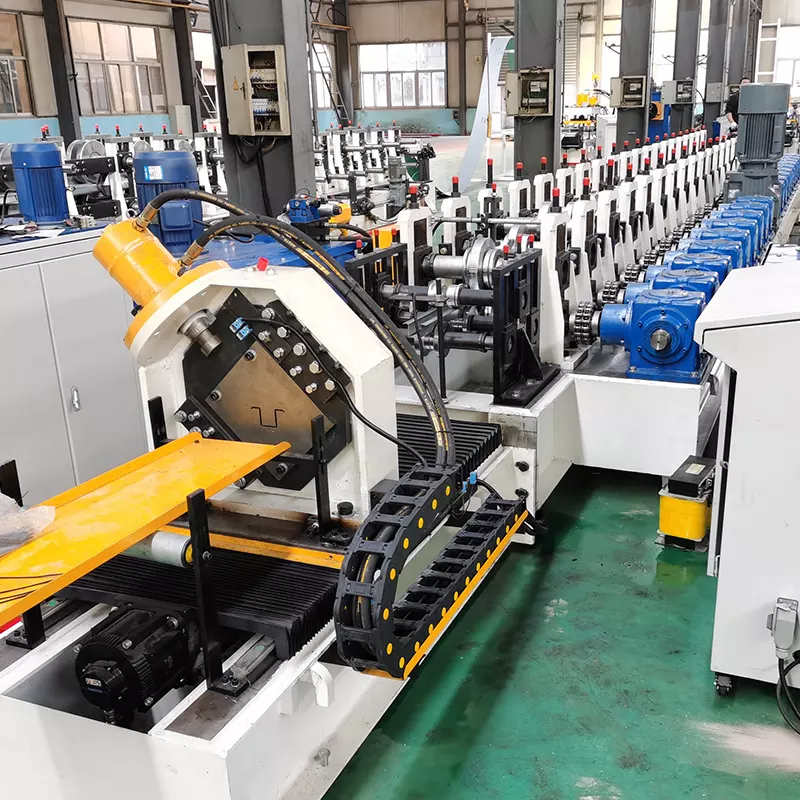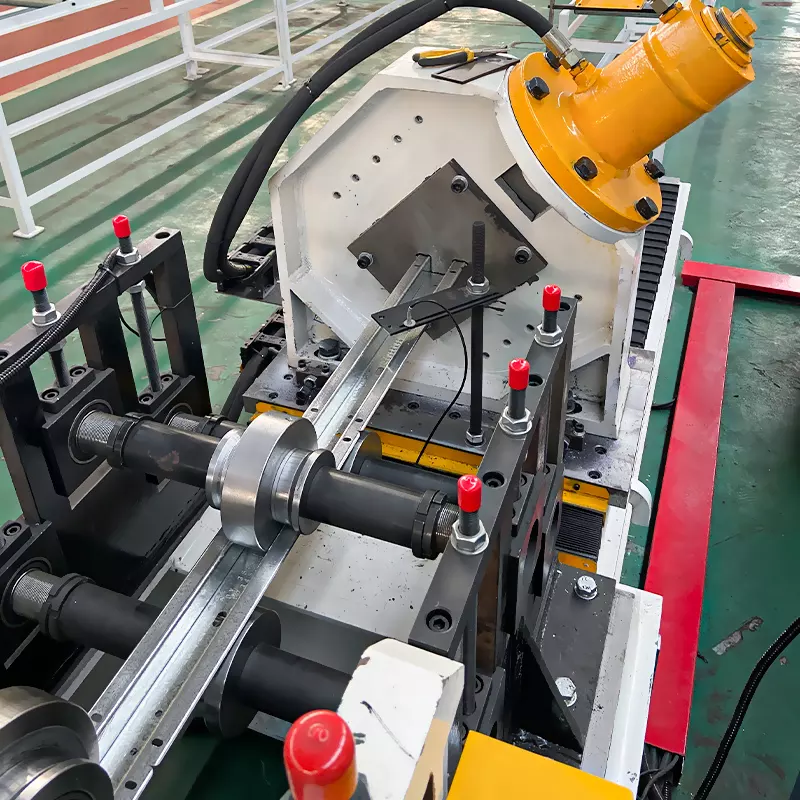Giriş
Bu bending radius in roll forming plays a crucial role in determining profile accuracy, material integrity, and overall production efficiency. Selecting the right bending radius ensures optimal forming performance, minimal defects, and extended machine life.
But how do you calculate the correct bending radius for roll forming applications? Ne gibi best practices for adjusting machine settings based on bending radius?
Bu kılavuzda şunları keşfedeceğiz:
✅ How bending radius impacts roll forming
✅ Recommended bending radii for different metals
✅ How to adjust roll forming machines for different radii
✅ Common bending radius problems & solutions
✅ How to optimize roll forming for small and large bending radii
Hadi içine dalalım the critical role of bending radius in roll forming and how to optimize your production for maximum efficiency in 2025!
How Bending Radius Affects Roll Forming
1. Material Stress & Spring-Back
- Smaller bending radii generate higher stress, increasing the risk of cracking and material fatigue.
- Larger bending radii azaltmak spring-back effectsBu da better dimensional accuracy.
2. Machine Load & Roller Wear
- Tighter bends require greater forceBu da higher wear on dies and rollers.
- Gradual bends distribute stress evenly, extending machine life.
3. Profile Accuracy & Surface Finish
- Incorrect bending radii can cause deformationsBu da poor-quality profiles.
- Optimized bending angles ensure smooth material flow, azaltılması surface imperfections.
4. Speed & Energy Consumption
- Tighter bends require slower speeds to allow gradual material flow.
- Wider bends can be formed faster, optimize etmek production efficiency.
Profesyonel ipucu: Correct bending radius selection can reduce forming defects by up to 30%!
Recommended Bending Radius for Different Metals
Different metals have unique bending properties, gerektiren specific bending radius ranges for optimal performance. Below is a comparison of recommended minimum bending radii for different metals.
| Malzeme Türü | Recommended Minimum Bending Radius (Times Material Thickness) | En İyi Uygulamalar |
|---|---|---|
| Hafif Çelik | 1.0 – 2.0× thickness | Structural components, roofing sheets |
| Paslanmaz Çelik | 2.0 – 3.0× thickness | Automotive, aerospace, medical equipment |
| Alüminyum | 1.5 – 3.0× thickness | Lightweight structures, HVAC, enclosures |
| Galvanizli Çelik | 1.0 – 2.5× thickness | Corrosion-resistant frames, construction materials |
| Copper & Brass | 0.5 – 1.5× thickness | Electrical components, decorative trim |
Profesyonel ipucu: Stainless steel requires larger bending radii due to its high spring-back effect!

How to Adjust Roll Forming Machines for Different Bending Radii
To ensure optimal roll forming performance, machines must be adjusted based on bending radius requirements. Aşağıda key machine settings that must be optimized:
1. Roller Die Design & Setup
Kullanım progressive forming passes to gradually achieve tight bends.
✅ Smaller bending radii require precision roller clearance önlemek için material cracking.
2. Forming Pressure & Speed Control
✅ Higher forming pressure is needed for smaller radii, but too much pressure can cause cracking.
✅ Slower forming speeds help control material stress and spring-back.
3. Lubrication & Cooling Adjustments
✅ Tight bends generate more friction, gerektiren increased lubrication to prevent surface damage.
✅ Cooling systems help manage heat buildup, reducing the risk of material fatigue.
4. Material Pre-Treatment & Annealing
✅ Annealing softens metalsiçin izin verir smaller bending radii without cracking.
✅ Yüzey işlemleri azaltmak friction and wear on rollers.
Profesyonel ipucu: Proper machine adjustments for bending radius can extend roller lifespan by 40%!
Common Roll Forming Bending Radius Issues & Solutions
Incorrect bending radius selection can lead to production defects, machine wear, and increased scrap rates. Aşağıdakiler common roll forming bending issues and their solutions.
| Problem | Neden | Çözüm |
|---|---|---|
| Edge Cracking | Bending radius too small | Increase bending radius, anneal material |
| Excessive Spring-Back | High-strength material with tight radius | Adjust roller clearance, use over-bending techniques |
| Surface Wrinkling | Insufficient roller support | Increase forming passes, optimize roller shape |
| Distorted Profile Shape | Uneven bending force | Recalibrate rollers, ensure balanced forming pressure |
| Roller Wear & Indentations | High friction in tight bends | Apply proper lubrication, use hardened steel rollers |
Profesyonel ipucu: 80% of bending defects are caused by incorrect machine adjustments—regular calibration is key!
Best Practices for Roll Forming Small & Large Bending Radii
Different strategies must be used when roll forming small and large bending radii için optimize forming accuracy and reduce defects.
Roll Forming Small Bending Radii (Tight Bends)
Kullanım multiple forming passes to gradually achieve tight bends.
✅ Reduce forming speed to allow material to flow smoothly without cracking.
✅ Başvur high-performance lubrication için minimize friction and surface wear.
Roll Forming Large Bending Radii (Wide Bends)
Kullanım increased roller spacing to allow for gradual bending without over-compression.
✅ Increase forming speed iyileştirmek için production efficiency.
Kullanım destek makaraları korumak için profile consistency.
Profesyonel ipucu: Tighter bends require more forming passes to distribute stress evenly!
Advanced Roll Forming Techniques for Achieving Precise Bending Radii
To achieve accurate and repeatable bending radii, manufacturers must employ advanced forming techniques that optimize material flow, reduce stress, and improve final product quality. Below are the most effective methods for controlling bending radius in roll forming.
1. Progressive Bending Passes for Tight Radii
- Gradual bending over multiple passes azaltır stress concentration, minimize etmek cracking risks.
- Sağlar smooth material flow, önlenmesi surface defects and distortions.
- Şunlar için ideal high-strength materials like stainless steel and titanium.
2. Over-Bending Compensation for Spring-Back Correction
- Spring-back is common in high-strength materials, gerektiren pre-calculated over-bending.
- Over-bending compensates for elastic recoverysağlamak final profile meets design specs.
- Essential for aluminum, stainless steel, and high-strength steel.
3. CNC-Controlled Roller Adjustment for Precision Bending
- Computer-controlled roller positioning allows for real-time bending radius adjustments.
- Azaltır operator errorsağlamak consistent forming accuracy.
- İçin en iyisi automotive and aerospace applications requiring tight tolerances.
Profesyonel ipucu: Using CNC-controlled roller adjustments can improve bending accuracy by 40%!
How to Optimize Roll Forming Speed for Different Bending Radii
Doğru seçimi yapmak forming speed için kritik öneme sahiptir. avoiding defects and ensuring material stability. Below is a comparison of optimal forming speeds based on bending radius.
| Bending Radius | Recommended Forming Speed (m/min) | Key Adjustments |
|---|---|---|
| Tight Radius (1.0× Material Thickness) | 5 – 15 m/min | Slow forming speed, increased lubrication |
| Medium Radius (1.5× – 3.0× Thickness) | 10 – 30 m/min | Balanced speed, controlled forming pressure |
| Large Radius (3.0× Thickness and Above) | 20 – 50 m/min | High-speed forming, optimized roller spacing |
Profesyonel ipucu: Tighter bends require slower forming speeds to prevent cracking and excessive stress buildup!
How to Reduce Material Waste When Roll Forming Different Bending Radii
Malzeme atıkları üretim maliyetlerini artırır ve verimliliği azaltır. Below are strategies to minimize scrap rates while maintaining bending accuracy.
1. Use Pre-Calibrated Roller Dies for Precise Bends
✅ Ensures repeatable accuracy, azaltılması trial-and-error adjustments.
✅ Prevents excessive material stretching that leads to waste.
2. Implement Smart Thickness & Radius Sensors
✅ Real-time monitoring of material thickness and bend angle önler over-bending or under-bending.
✅ AI-driven systems can auto-correct roller pressure, optimize etmek waste reduction.
3. Optimize Coil Feed & Tension Control
✅ Maintaining consistent material flow önler uneven bends and misalignment.
Azaltır material scrap due to incorrect bend formation.
Profesyonel ipucu: AI-powered bending control can reduce material waste by up to 25%!
Common Roll Forming Bending Radius Challenges & Solutions
Handling different bending radii can pose various challenges. Aşağıdakiler common problems and their solutions.
| Problem | Neden | Çözüm |
|---|---|---|
| Cracking in Tight Radii | Excessive forming force on brittle materials | Use gradual bending passes, anneal material |
| Excessive Spring-Back | High-strength material with tight radius | Adjust roller clearance, apply over-bending techniques |
| Distorted Profile Shape | Uneven roller force distribution | Optimize roller alignment, balance forming pressure |
| Roller Indentations on Surface | Excessive friction during forming | Apply proper lubrication, use hardened steel rollers |
| Edge Waviness | Incorrect material feed tension | Adjust coil tension, ensure smooth material flow |
Profesyonel ipucu: 80% of forming defects are caused by incorrect machine adjustments—regular calibration is key!

Best Practices for Roll Forming Machines Handling Multiple Bending Radii
To efficiently process profiles with varying bending radii, follow these en i̇yi̇ uygulamalar:
1. Use Multi-Stage Roller Dies
✅ Allows gradual transition between tight and wide bends, azaltılması stress concentration.
✅ Prevents material cracking and spring-back inconsistencies.
2. Implement Quick-Change Tooling for Radius Adjustments
✅ Enables fast adjustments for different bending radii, improving üreti̇m esnekli̇ği̇.
Azaltır setup time, improving overall efficiency.
3. Invest in Adaptive Forming Technology
✅ AI-driven forming systems automatically adjust roller clearance, speed, and pressure.
✅ Ensures consistent profile accuracy across complex bending requirements.
4. Maintain Proper Lubrication & Cooling Control
✅ Tighter bends generate more heat, gerektiren advanced cooling systems.
✅ High-speed forming needs controlled lubrication önlemek için silindir aşınması.
Profesyonel ipucu: Adaptive forming technology can improve production speed by up to 30%!
FAQ: Roll Forming Bending Radius & Machine Optimization
1. What is the minimum bending radius for roll forming?
- The minimum bending radius depends on material type, but typically ranges from 1.0× to 3.0× material thickness.
2. How do I prevent cracking when forming small bending radii?
- Kullanım annealed materials, increase forming passesve apply proper lubrication.
3. How do I adjust my machine when switching to a larger bending radius?
- Increase roller spacing, adjust forming pressureve optimize roller design.
4. Why does my roll-formed part have excessive spring-back?
- This occurs with high-strength materials. Use over-bending techniques ve optimize roller pressure.
5. Where can I buy roll forming machines that support different bending radii?
İçin özel yapim rulo şeki̇llendi̇rme maki̇neleri̇, ziyaret edin WUXI SUNWAY MAKİNA A.Ş., LTD.
Son Düşünceler
Doğru seçimi yapmak bending radius için gereklidir. high-precision, defect-free roll forming. By optimizing machine settings, using proper lubrication, and adjusting forming passesüreticiler şunları yapabilir reduce defects, improve production efficiency, and extend machine life.
WUXI SUNWAY MAKİNA A.Ş., LTD bir lider küresel üretici . özel yapim rulo şeki̇llendi̇rme maki̇neleri̇, teklif ileri teknoloji, uzman desteği ve rekabetçi fiyatlandırma.
Want to optimize your roll forming bending radius? Bugün bize ulaşın!
